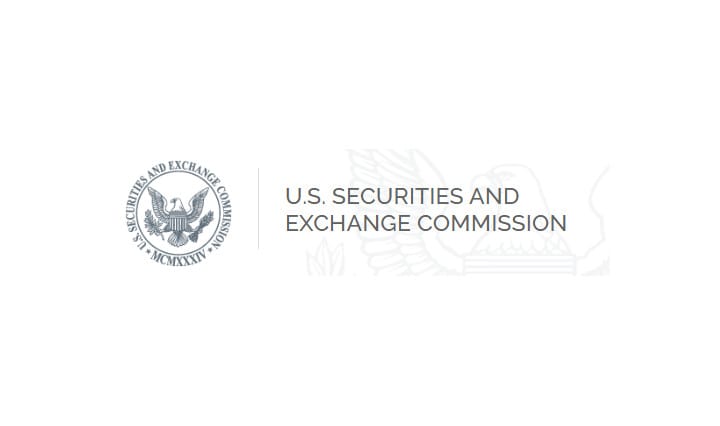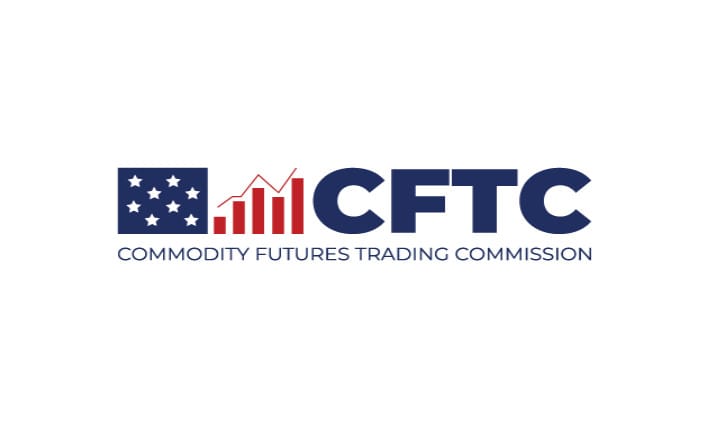Commissioner Hester M. Peirce: "I write to dissent from the latest unwarranted expansion of Form PF. These revisions stem from the Commission’s unbridled curiosity rather than from a legitimate regulatory objective."
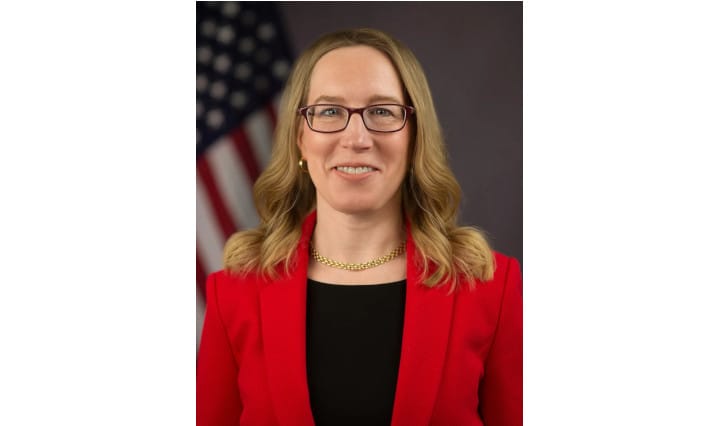
Curiouser and Curiouser: Statement on Amendments to Form PF to Amend Reporting Requirements for All Filers and Large Hedge Fund Advisers
I write to dissent from the latest unwarranted expansion of Form PF. These revisions stem from the Commission’s unbridled curiosity rather than from a legitimate regulatory objective. In 2010, Congress established the Financial Stability Oversight Council (“FSOC”) and charged it with, among other things, “identify[ing] risks to the financial stability of the United States.”[2] Congress directed the Securities and Exchange Commission (“SEC” or “Commission”) and the Commodity Futures Trading Commission (“CFTC”) (collectively, “Commissions”) to provide some of the information FSOC would need to fulfill its duties, and so in 2011 Form PF was born.[3]
At its inception, the Commissions acknowledged that, while Form PF data could be used for their own regulatory purposes, Form PF’s primary function was “to collect information . . . to assist FSOC in its monitoring obligations.”[4] Since that time, however, respect for Form PF’s primary purpose has given way to curiosity. We pair as co-equal FSOC’s use of Form PF data to “monitor[] and assess[] systemic risk” with our own desire “to collect additional data and make data more useful for the Commissions’ use in their respective regulatory programs.”[5] Relying on both these purposes, we are expanding dramatically the information Form PF collects.
In the Form’s early days, we were comfortable with its limitations. We stated clearly, for instance, that “[w]e have not sought to design a form that would provide FSOC in all cases with all the information it may need to make a determination that a particular entity should be designated for supervision by the [Federal Reserve Board].”[6] We recognized that the cost of demanding more information from all fund advisers would outweigh the benefits. Our sensibilities have changed in the intervening thirteen years, and Form PF is being amended to accommodate them.[7]
Despite this attitudinal shift, we continue to provide occasional lip service to the idea that these amendments have been made largely in pursuit of improving the identification and monitoring of systemic risk. As one commenter correctly highlighted, however, neither we nor the CFTC “describe[s] the types of activities that may give rise to systemic risk, nor do [we] describe how the proposed reporting requirements are specifically tailored to identify and effectively monitor these activities.”[8] Form PF has not-so-subtly morphed into an all-purpose means to gather information from the private market under the seemingly limitless rubric of systemic risk. Through strained logic, we manage to transform one-off reports describing the idiosyncrasies of individual private funds into harbingers of market-wide contagion.
Our apparent inability to articulate a rationale for compelling more data has in no way blunted our craving for it—in fact, it appears to have stoked it. Absent any discernible limiting features, we have seemingly decided that all gaps are created equal and filling them provides its own justification. Even a partial list of the additional data we will now collect with these revisions is dizzying.[9] As one commenter put it, “the Commissions appear to believe that monitoring for systemic risk and protecting investors may only be conducted by having access to every piece of fund-related data.”[10] A systemic risk regulator does not need to know everything about every entity.
Boundless curiosity is wonderful in a small child; it is a less attractive trait in regulatory agencies. As diligent regulators we should want to know why market disturbances occur, or even prevent them if we can do so without exceeding our statutory mandates. But we chase a white whale if we believe we are but one discrete piece of information away from being able to prevent the next Flash Crash or Global Financial Crisis.
We insist, for instance, that each component fund in a master-feeder arrangement be reported separately. We ignored commenters who pointed out that disaggregation makes little sense in light of how private funds manage risk[11] and that the information submitted will be of little use to the Commission.[12] We dismiss these concerns by stating that this fund-level data “allows for a clearer understanding of the reporting fund’s structure, including its portfolio liquidity.”[13] And besides, we say, “the disaggregated data can still be aggregated by FSOC and the Commissions if necessary to understand and assess the risk of the fund.”[14] The Commissions similarly reject a commonsense request for an exception to allow disregarded feeder funds to invest a de minimis amount in something other than a single master fund, U.S. treasury bills, or cash and cash equivalents.[15] Even a ten percent exception could cloud “our understanding of these funds and the risks they may pose.”[16] We likewise said no to calls to carve out certain private funds from the definition of hedge fund—such as private funds that can short or use leverage, but do not engage in those activities for a specified period of time.[17] Allowing carveouts from the definition, we determined, among other problems, would mean that we “would not receive important reporting on these activities which may contribute to systemic risk, particularly in the event of a fund that has the ability to engage in borrowing or short selling activities.”[18]
We do not have the better argument here. We have failed to explain why we must collect a small, unrepresentative component of the whole in order to fulfill Form PF’s purpose. Systemic risk involves the forest—trying to monitor the state of every individual tree at every given moment in time is a distraction and trades off the mistaken belief that we have the capacity to draw meaning from limitless amounts of discrete and often disparate information. Unbridled curiosity seems to be driving this decision rather than demonstrated need.
In our never-satisfied hunger for more particularized information, we too casually ignore concerns about cost, utility, and data protection. Form PF contains highly proprietary information. Unless we need it, we should not collect it. The leakage of such confidential business information could have serious competitive repercussions. What we put forward as streamlining of Form PF’s data gathering effort—say the drop-down menus to assist a filer in identifying its investment strategy,[19] or the introduction of sub-asset classes—commenters rightly see as costly fact-gathering endeavors of little value that create an increasingly tempting target for cyberthieves.[20] Our curiosity could have serious consequences—“an intrusive path into the proprietary workings of fund managers under the guise of regulatory ‘need to know’.”[21] Ensuring that the data we collect are used only for their intended regulatory purposes is a very weighty responsibility—so weighty that it ought to have us thinking twice about collecting data that is not needed for systemic risk assessment.
Moreover, as one commenter suggests, perhaps we should ensure that we have fully used the information we already receive before adding to private funds’ reporting burden.[22] Given that the last amendments are less than a year old, private funds might justifiably be feeling Form PF fatigue.[23]
The final rule does incorporate some commenter suggestions to reduce the costs and burdens and duplication associated with some of the proposal’s features,[24] which could indicate that the notice and comment process has worked as designed. Far from it. The Commissions dismissed far too many comments calling for revisions or relief, but more troubling, countless numbers of similar pleas likely were never submitted. By my count, we acknowledge that the Commissions received no comment on an element of the proposal more than 40 times in this release. Overburdened commenters are forced to pick and choose among hundreds of questions posed in this and other releases. They concentrate their limited time and strained resources on those matters they believe will be particularly disruptive.[25] With so many questions going unaddressed, we cannot be confident that we have a clear understanding of what the true costs of these amendments will be, let alone whether they are justified. For these reasons and others, I cannot support this rule.
Commenters are not alone in being overburdened. I am grateful to the hardworking staff of the Securities and Exchange Commission and the CFTC. Form amendments can be particularly challenging, especially with respect to a joint form such as this one and without the benefit of comment on many sections of the proposal. I commend the staffs of both agencies for their diligence and professionalism.
[1] Lewis Carroll, Alice’s Adventures in Wonderland, at 2.
[2] Dodd-Frank § 112(a)(1).
[3] Dodd-Frank §§ 404 (adding 15 U.S.C. 80b-4(b)(1)) (in a section titled “Collection of Systemic Risk Data; Reports; Examinations; Disclosures”) and 406 (adding 15 U.S.C. 80b-11) (requiring the SEC and CFTC, after consulting with FSOC, to “jointly promulgate rules to establish the form and content of the reports required to be filed with the Commission under subsection 204(b)”).
[4] See Reporting by Investment Advisers to Private Funds and Certain Commodity Pool Operators and Commodity Trading Advisors on Form PF, Investment Advisers Act Release No. 3145 (January 26, 2011) ("Original Proposal”), at 17 https://www.sec.gov/files/rules/proposed/2011/ia-3145.pdf (“While we are proposing to collect information on Form PF to assist FSOC in its monitoring obligations under the Dodd-Frank Act, the information collected on Form PF would be available to assist the Commissions in their regulatory programs, including examinations and investigations and investor protection efforts relating to private fund advisers. We have designed Form PF, in consultation with staff representing FSOC’s members, to provide FSOC with such information so that it may carry out its monitoring obligations.”).
[5] Adopting Release at 5-6 (“Based on this experience and in light of these changes, the Commissions and FSOC have identified significant information gaps and situations where revised information would improve the Commissions’ and FSOC’s understanding of the private fund industry and the potential systemic risk posed by it, as well as further investor protection efforts. Accordingly, to enhance FSOC’s monitoring and assessment of systemic risk and to collect additional data and make data more useful for the Commissions’ use in their respective regulatory programs, in August 2022, the Commissions proposed amendments to enhance the information advisers file on Form PF and improve data quality.”) (emphasis added).
[6] Original Proposal at 18 (“We have not sought to design a form that would provide FSOC in all cases with all the information it may need to make a determination that a particular entity should be designated for supervision by the FRB. Such a form, if feasible, likely would require substantial additional and more detailed data addressing a wider range of possible fund profiles, since it could not be tailored to a particular adviser, and would impose correspondingly greater burdens on private fund advisers. This type of information gathering may be better accomplished by OFR through targeted information requests to specific private fund advisers identified through
Form PF, rather than through a general reporting form.”) (internal citations removed).
[7] See, e.g., Adopting Release at 205-6 (“However, we continue to believe that a private fund of any size that provides for withdrawal or redemption rights may be affected by increased investor withdrawals during certain market events and/or vulnerable to failure as a result of investor redemptions, and so the additional data will be relevant for assessing broader systemic risk, for example by allowing the Commissions and FSOC to assess the prevalence of the exercise of withdrawal and redemption rights to identify potential patterns among affected funds that may signal stress at a particular fund or across many funds.”) (emphasis added).
[8] See, e.g., Comment Letter from SIFMA-AMG at 4 (Oct. 11, 2022) (“The Commissions, however, do not describe the types of activities that may give rise to systemic risk, nor do they describe how the proposed reporting requirements are specifically tailored to identify and effectively monitor these activities.”), https://www.sec.gov/comments/s7-22-22/s72222-20145436-310658.pdf. (“SIFMA-AMG Letter”)
[9] See, e.g., Adopting Release note 552 (“Other revisions that will provide this benefit include revising reporting of regulatory versus net assets under management; reporting of assumptions the adviser makes in responding to questions on Form PF; reporting of types of fund; reporting of master-feeder arrangements, internal/external private funds, and parallel fund structures; reporting of monthly gross and net asset values; reporting of the value of unfunded commitments; reporting on the value of borrowing activity; reporting of fair value hierarchy; reporting of beneficial ownership; reporting of fund performance; more granular reporting of hedge fund strategies; more granular reporting of hedge fund counterparty exposures including identification of counterparties representing a fund’s greatest exposure; and more granular reporting of hedge fund trading and clearing mechanisms.”).
[10] SIFMA-AMG Letter at 4 (“Rather, the Commissions appear to believe that monitoring for systemic risk and protecting investors may only be conducted by having access to every piece of fund-related data. Gathering granular data from all investment advisers does not inherently equate to systemic risk monitoring.”).
[11] See, e.g., Comment Letter from the Managed Fund Association at 3 (Dec. 7, 2022) (“Although advisers may form master-feeder structures and utilize trading vehicles to increase efficiency for investors, the broader private fund structures that those entities are part of are nonetheless managed on a consolidated or aggregated basis. Private fund advisers typically do not manage each feeder fund, master fund or trading vehicle within a private fund structure on a stand-alone basis with respect to risk management, financing, or liquidity. Rather, advisers frequently consider these matters from the perspective of the aggregated, consolidated activities of the private fund structure.”), https://www.sec.gov/comments/s7-22-22/s72222-20152435-320304.pdf. (“MFA Letter”)
[12] See, e.g., Comment Letter from the Alternative Investment Management Association Limited and the Alternative Credit Council at 7 (Oct. 11, 2022) (“We see no reason why advisers should be required to report feeder-level information in a fund of fund structure any differently than they report a one-to-one master-feeder structure, nor do we recognize any purported value this information will provide the Commissions.”), https://www.sec.gov/comments/s7-22-22/s72222-20145440-310665.pdf. ("AIMA Letter”)
[13] Adopting Release at 158 (“[D]isaggregated reporting, rather than being misleading, allows for a clearer understanding of the reporting fund’s structure, including its portfolio liquidity, because we can observe liquidity on a fund by fund basis while continuing to allow aggregation of data across the fund structure for the broader context.”).
[14] Adopting Release at 15.
[15] See AIMA Letter at 9 (“We believe the definition of ‘disregarded feeder’ as set out in proposed Instruction 6 should be revised to read: ‘feeder fund that invests all at least 80% of its assets in (i) a single master fund, and/or (ii) cash and cash equivalents, and/or (iii) government securities.’ This would allow a feeder fund to have a de minimis amount for direct investment which would be particularly helpful where derivatives or other instruments are held for currency class hedging or other reasons.”) (cross-outs and emphasis in the original) (emphasis in original); MFA Letter at 13 ("The Commissions should revise the definition to permit a ‘disregarded feeder fund’ to invest up to 10 percent of its capital in other investments that are not a single master fund or cash equivalents.”).
[16] Adopting Release at 17 (“In contrast, a feeder fund that does not invest all of its assets in a single master fund or cash and cash equivalents operates and invests in a different manner, and it is critical to our understanding of these funds and the risks that they may pose to receive disaggregated reporting of these fund arrangements because such feeder funds will generally have distinct risk exposures than their associated master funds.”).
[17] See, e.g., Comment Letter from the American Investment Council AIC at 8 (Oct. 11, 2022) (“The AIC recommends an amendment to the definition of ‘hedge fund’ to avoid potential data mismatches and to improve data quality as a result of the over-inclusive nature of the definition. Specifically, the AIC recommends that the definition only include funds that have engaged in shorting or borrowing activity over a 12-month period and provide a de minimis exception for shorting activity relative to the size of the private fund.”), https://www.sec.gov/comments/s7-22-22/s72222-20145432-310653.pdf.
[18] Adopting Release at 162.
[19] Adopting Release at 77. The list of strategies from which to choose will undoubtedly cause many filers analysis paralysis, but the Commissions assure us that it will facilitate “more targeted analysis and improve comparability”: equity (and associated sub-strategies such as long/short market neutral, long only, long/short short bias, and long/short long bias), macro (and associated sub-strategies such as active trading, commodity, currency, and global macro), convertible arbitrage, relative value (and associated strategies such as fixed income asset backed, fixed income convertible arbitrage, fixed income corporate, fixed income sovereign, fixed income arbitrage, and volatility arbitrage), event driven (and associated sub-sub-strategies such as distressed, distressed/restructuring, risk arbitrage/merger arbitrage, equity special situations, and special situations), credit (and associated sub-strategies such as asset based lending, litigation finance, emerging markets, and asset backed/structured products), managed futures/CTA (and associated sub-strategies such as fundamental, quantitative), investment in other funds, private credit (and associated sub-strategies such as direct lending/mid-market lending, distressed debt, junior/subordinate debt, mezzanine financing, senior debt, senior subordinated debt, special situations, venture debt, and other), private equity (and associated sub-strategies such as early stage, expansion/late stage, buyout, distressed, growth, private investment in private equity, secondaries, and turnaround), real estate, real estate investment trusts, real assets excluding real estate, annuity and life insurance policies, litigation finance, digital assets, general partner stakes investing, cash and cash equivalents, and other.
[20] See, e.g., SIFMA-AMG Letter at 7 (“Moreover, the Commissions should not seek information in an effort to monitor systemic risk unless that information is narrowly tailored, particularly when that information could give rise to confusion and security concerns. *** Second, the provision of granular sub-asset class information may allow those with access to the information (whether sanctioned or unsanctioned) to recreate a fund’s investment strategy which, if duplicated or made public, in whole or in part, could lead to investor harm instead of the investor protection that the Proposal purports to seek to achieve. We are concerned that the provision of such detailed information could disclose a fund’s investment strategy and, thus, this information should only be provided when there is a true need to have this level of detail about a fund’s investments.”); MFA Letter at 18 (“Further, the requirement to categorize net asset values in many small strategy buckets is unlikely to be useful for regulators and will require extensive calculations and subjective decisions, especially for the large percentage of funds that combine more than one investment strategy.”); AIMA Letter at 6, https://www.sec.gov/comments/s7-22-22/s72222-20145440-310665.pdf (“The systems built to assist with the reporting burden of the current Form PF will need to be broken down and rebuilt from the start in order to properly integrate the new requirements. From a cost and effort perspective, this should be estimated as being tantamount to the original build cost which itself far exceeded the amounts originally estimated by the Commissions.”).
[21] AIMA Letter at 2 (“The resulting massive collection of data from this Proposal, particularly when combined with the requirements of other existing and proposed rules, would represent far more than a necessary window into adviser activity. The granularity of the aggregate data collected would provide an intrusive path into the proprietary workings of fund managers under the guise of regulatory ‘need to know.’”).
[22] See SIFMA-AMG Letter at 4 (“While fund data is informative and interesting, a rulemaking with the goal of monitoring for systemic risk and protect sophisticated investors should meet a higher standard before burdensome reporting is compelled. SIFMA AMG believes that the Commissions should monitor for systemic risk in a more nuanced fashion and should leverage existing data sources when doing so. In addition, the Commissions should provide a robust cost-benefit analysis to support the costs associated with the Proposal’s new reporting requirements in light of the burdens they would introduce.”)
[23] “SEC Adopts Amendments to Enhance Private Fund Reporting.” May 3, 2023, https://www.sec.gov/news/press-release/2023-86. Press release.
[24] See, e.g., Adopting Release at 105 (“One commenter recommended allowing an adviser to select the sub-asset class that ‘best represents’ the position. We believe that adopting a ‘best represents’ standard, regardless of the position size, balances the importance of obtaining more accurate and granular data with a reporting standard that is less burdensome for advisers than the proposed standard.”); and at 188 (“The revisions include changes to instructions for purposes of clarification, revising framing or explanation of questions where commenters made suggestions to improve data quality, revising instructions to avoid duplicative reporting or to otherwise ease burden, or forgoing adopting certain amendments entirely.”).
[25] See, e.g., Comment Letter from Schulte Roth at 2 (Oct. 11, 2022) (“In light of the complexity of the proposals, and the timing of the comment period, it is not feasible to analyze all of the proposed changes, their implications and to identify alternatives. We would welcome the opportunity to have more time to study the proposals and provide additional comments. In the meantime, below are some responses to specific questions about which the Commissions seek comment.”), https://www.sec.gov/comments/s7-22-22/s72222-20145429-310650.pdf.
What Hester finds to be unwarranted
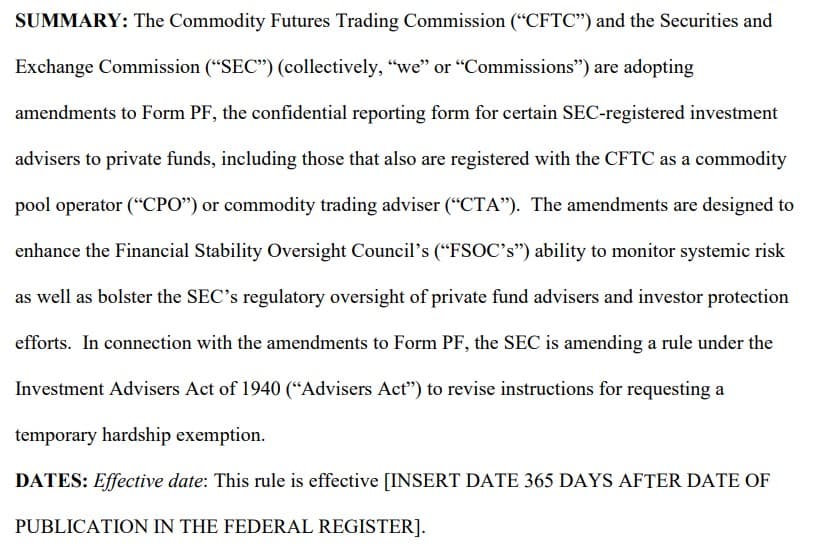
Wut Mean?
Among other things, the amendments to Form PF will enhance how large hedge fund advisers report investment exposures, borrowing and counterparty exposure, market factor effects, currency exposure, turnover, country and industry exposure, central clearing counterparty reporting, risk metrics, investment performance by strategy, portfolio liquidity, and financing and investor liquidity to provide better insight into the operations and strategies of these funds and their advisers and improve data quality and comparability.
Further, the amendments will require additional basic information about advisers and the private funds they advise, including identifying information, assets under management, withdrawal and redemption rights, gross asset value and net asset value, inflows and outflows, base currency, borrowings and types of creditors, fair value hierarchy, beneficial ownership, and fund performance to provide greater insight into private funds’ operations and strategies, to assist in identifying trends, including those that could create systemic risk, to improve data quality and comparability, and to reduce reporting errors.
The amendments will also require more detailed information about the investment strategies, counterparty exposures, and trading and clearing mechanisms employed by hedge funds, while also removing duplicative questions, to provide greater insight into hedge funds’ operations and strategies, to assist in identifying trends, and to improve data quality and comparability.
Fact Sheet
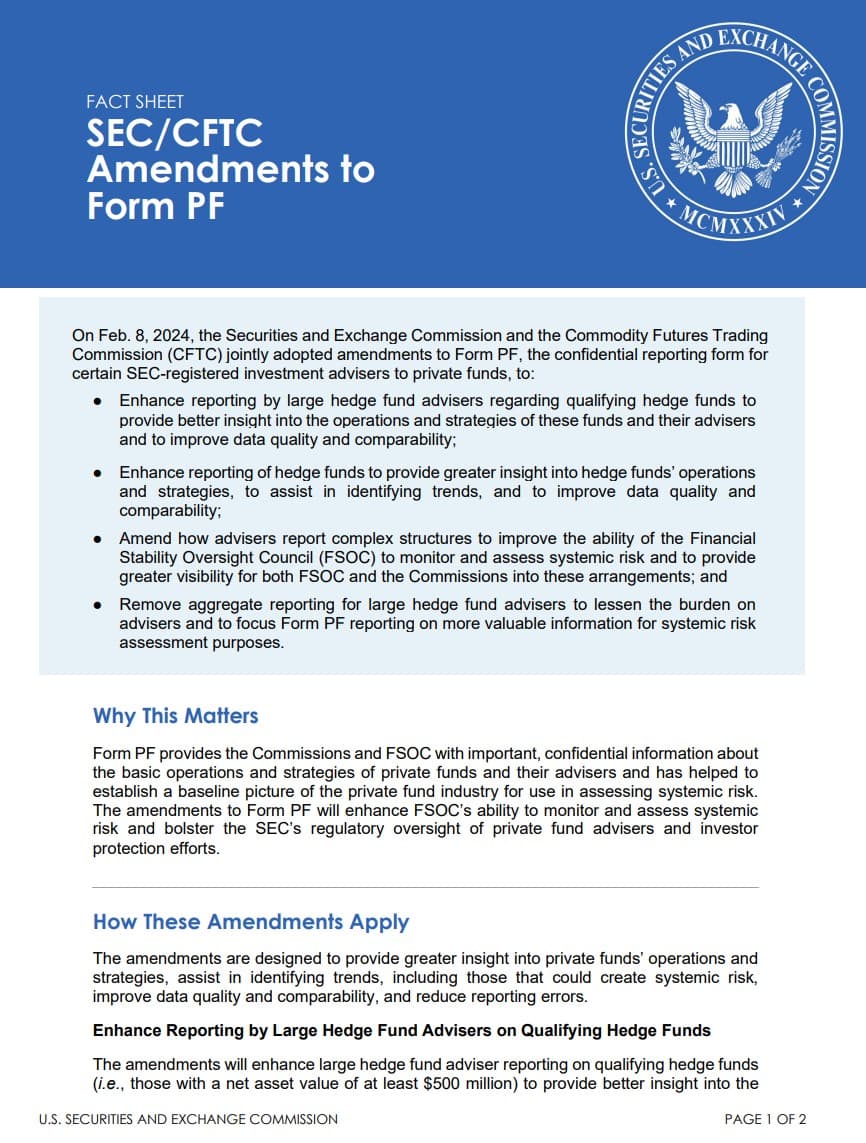
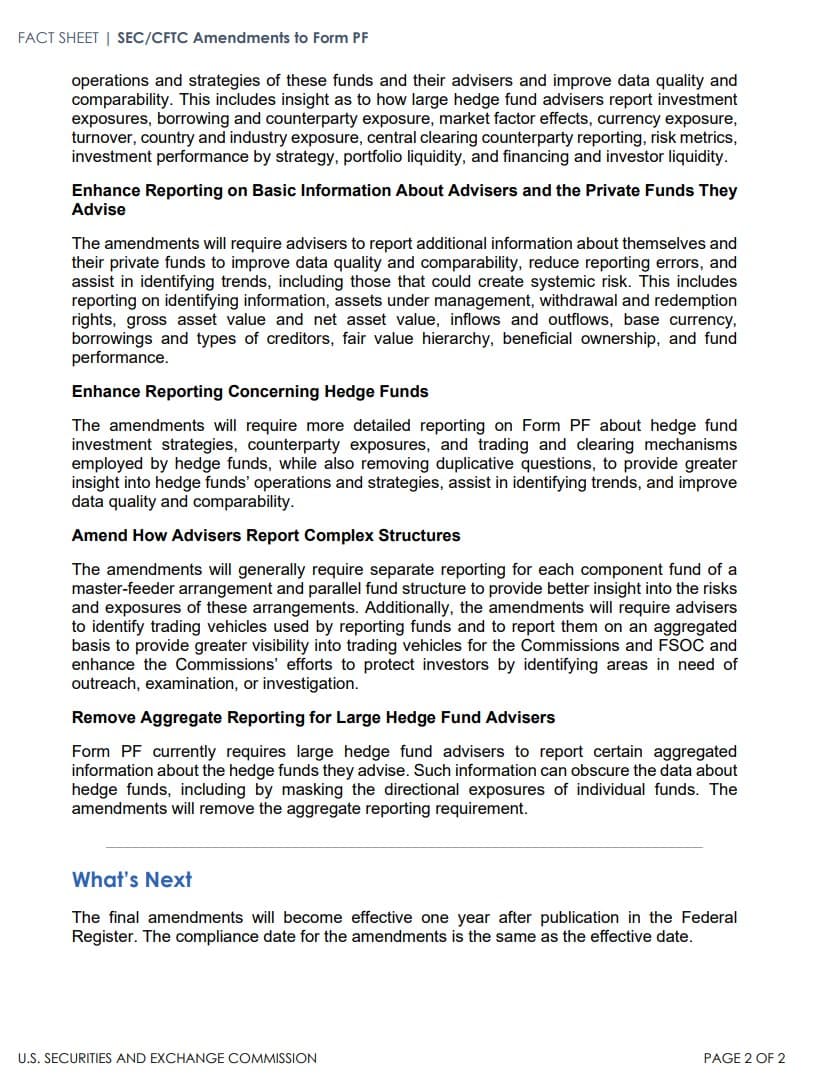

TLDRS
- Commissioner Hester M. Peirce: "I write to dissent from the latest unwarranted expansion of Form PF. These revisions stem from the Commission’s unbridled curiosity rather than from a legitimate regulatory objective."
- The amendments to Form PF will enhance reporting by large hedge fund advisers on various aspects such as investment exposures, borrowing, counterparty exposure, risk metrics, and investment performance to improve insight into fund operations and strategies, and enhance data quality and comparability.
- Additional information will be required about advisers and the private funds they manage, including details on assets under management, withdrawal rights, gross and net asset values, inflows and outflows, and fund performance, aimed at providing a deeper understanding of private funds’ operations, assisting in trend identification, and reducing reporting errors.
- The changes will also demand more detailed reporting on investment strategies, counterparty exposures, and trading and clearing mechanisms, while eliminating redundant questions to offer a clearer view of hedge funds’ operations and strategies, help in trend analysis, and enhance data quality and comparability.
- Goes into affect 1 year after being published in the Federal Register.

